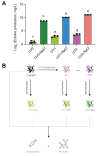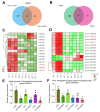Expression of ABC transporters negatively correlates with ectoine biosynthesis in Halomonas campaniensis under NaCl and ultraviolet mutagenesis treatments revealed by transcriptomic and proteomics combined analysis
- PMID: 39567869
- PMCID: PMC11577897
- DOI: 10.1186/s12864-024-11003-9
Expression of ABC transporters negatively correlates with ectoine biosynthesis in Halomonas campaniensis under NaCl and ultraviolet mutagenesis treatments revealed by transcriptomic and proteomics combined analysis
Abstract
Halomonas species are renowned for their production of organic compatible solutes, particularly ectoine. However, the identification of key regulatory genes governing ectoine production in Halomonas remains limited. In this study, we conducted a combined transcriptome-proteome analysis to unveil additional regulatory genes influencing ectoine biosynthesis, particularly under ultraviolet (UV) and salt conditions. NaCl induction resulted in a 20-fold increase, while UV treatment led to at least 2.5-fold increases in ectoine production. The number of overlapping genes between transcriptomic and proteomic analyses for three comparisons, i.e., non-UV with NaCl (UV0-NaCl) vs. non-UV without NaCl (UV0), UV strain 1 (UV1-NaCl) vs. UV0-NaCl, and UV strain 2 (UV2-NaCl) vs. UV0-NaCl were 137, 19, and 21, respectively. The overlapped Gene Ontology (GO) enrichments between transcriptomic and proteomic analyses include ATPase-coupled organic phosphonate, phosphonate transmembrane transporter activity, and ATP-binding cassette (ABC) transport complex in different comparisons. Furthermore, five common genes exhibited different expression patterns at mRNA and protein levels across the three comparisons. These genes included orf01280, orf00986, orf01283, orf01282 and orf01284. qPCR verification confirmed that three of the five common genes were notably under-expressed following NaCl and UV treatments. This study highlighted the potential role of these five common genes in regulating ectoine production in Halomonas strains.
Keywords: Halomonas; Ectoine; Proteome; Salt treatments; Transcriptome; Ultraviolet.
© 2024. The Author(s).
Conflict of interest statement
Declarations. Ethics approval and consent to participate: Not applicable. Consent for publication: Not applicable. Competing interests: The authors declare no competing interests.
Figures






Similar articles
-
Study of osmoadaptation mechanisms of halophilic Halomonas alkaliphila XH26 under salt stress by transcriptome and ectoine analysis.Extremophiles. 2022 Mar 1;26(1):14. doi: 10.1007/s00792-022-01256-1. Extremophiles. 2022. PMID: 35229247
-
New type of osmoregulated solute transporter identified in halophilic members of the bacteria domain: TRAP transporter TeaABC mediates uptake of ectoine and hydroxyectoine in Halomonas elongata DSM 2581(T).J Bacteriol. 2002 Jun;184(11):3078-85. doi: 10.1128/JB.184.11.3078-3085.2002. J Bacteriol. 2002. PMID: 12003950 Free PMC article.
-
Comparative genomic analysis of Halomonas campaniensis wild-type and ultraviolet radiation-mutated strains reveal genomic differences associated with increased ectoine production.Int Microbiol. 2023 Nov;26(4):1009-1020. doi: 10.1007/s10123-023-00356-y. Epub 2023 Apr 17. Int Microbiol. 2023. PMID: 37067733 Free PMC article.
-
Microbial production of ectoine and hydroxyectoine as high-value chemicals.Microb Cell Fact. 2021 Mar 26;20(1):76. doi: 10.1186/s12934-021-01567-6. Microb Cell Fact. 2021. PMID: 33771157 Free PMC article. Review.
-
Establishing Halomonas as a chassis for industrial biotechnology: advances in synthetic biology tool development and metabolic engineering strategies.Microb Cell Fact. 2025 Jun 12;24(1):133. doi: 10.1186/s12934-025-02757-2. Microb Cell Fact. 2025. PMID: 40506695 Free PMC article. Review.
References
-
- Dong Y, Zhang H, Wang X, Ma J, Lei P, Xu H, Li S. Enhancing ectoine production by recombinant Escherichia coli through step-wise fermentation optimization strategy based on kinetic analysis. Bioprocess Biosyst Eng. 2021;44:1557–66. - PubMed
MeSH terms
Substances
Grants and funding
LinkOut - more resources
Full Text Sources

